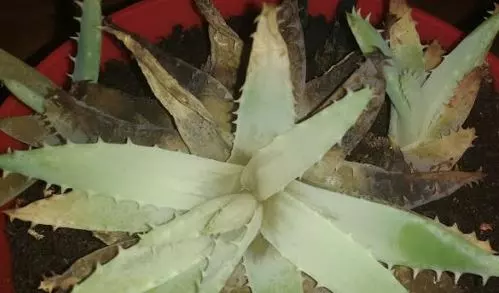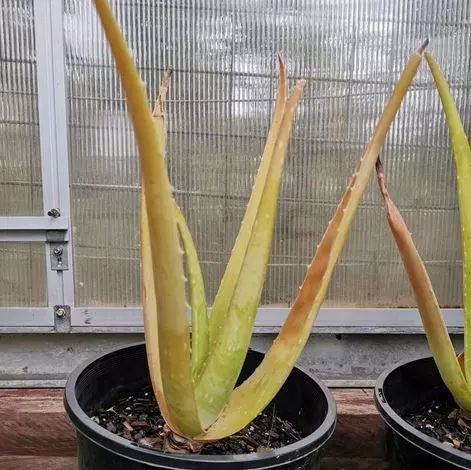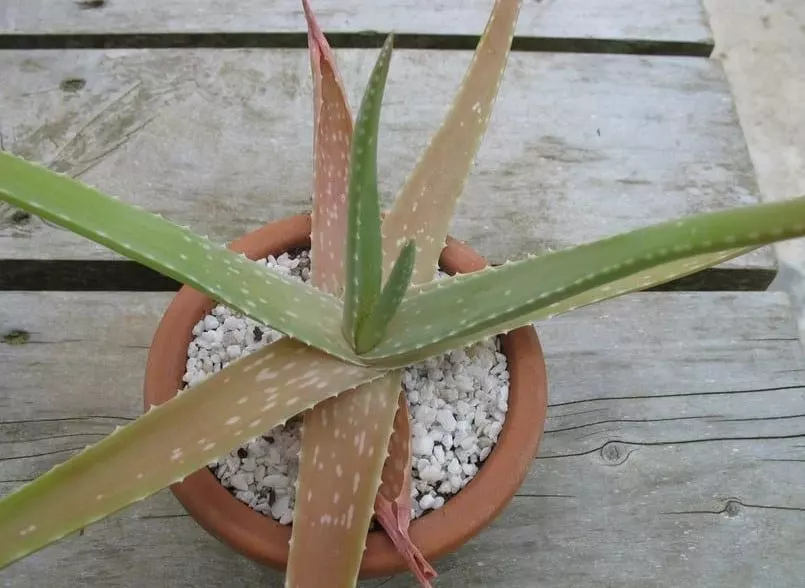In this article, we will talk about the Aloe plant turning brown. Aloe is one of the easiest succulent plants to care for, and it is also very comfortable living indoors, even though it is not a houseplant. Few problems beset it, as long as it has a well-drained substrate, a good amount of light, and adequate watering.
Table of Contents
Why Is My Aloe Plant Turning Brown?
If you’ve made it this far, tell me I’m not wrong if I say you have any of these questions: Why is my Aloe Vera turning brown, why is my Aloe Vera brown, why are its leaves brown? Don’t worry because here are the 6 main reasons why the Aloe plant turns brown.
- Aloe plant turning brown due to Excess water
- why is my aloe plant turning brown? Due to the water shortage
- Aloe plant turning brown due to exposure to extreme temperatures
- Due to Chemical products
- Due to Excess salts in the soil
- Aloe vera plant turning brown and soft due to Diseases
Aloe plants turning brown and wilting can be caused by any of the conditions named above. However, all is not lost yet.
If your Aloe is turning brown, read on to learn more about the causes and how to fix it.
Reasons Why the Aloe Plant Turning Brown
Aloe plants, when they are healthy, present plump leaves and many offspring, and these Aloe babies are the main indications that a plant is healthy; if a plant is giving you offspring, it means that it is in good condition.
To begin to address the main causes why an Aloe plant, or some of its leaves, begin to darken and turn brown, greenish, gray, and even purple, we need to keep in mind its main characteristic:
This plant is considered a natural, useful, and affordable medicine, which possesses incredible healing properties in gel form.
Exactly; gel, crystal, juice, you can call it whatever you want, but where he retains its miraculous qualities is in its internal liquid, which is primarily water. This ability to store water in its leaves and classify it as a succulent plant will be the key to understanding why the leaves darken.
So, if it retains water inside… let’s give it water! Lots of water! That’s what our logic tells us, right? However, despite having this watery gel inside, they tend to want to be a bit dry and therefore, most problems are caused by overwatering or the wrong planting medium (substrate) holding too much water.
Not all water-related problems are excessive watering, as brown aloe vera plants can suffer from too much or too little moisture. Certain people, too careless or too busy, tend to forget about their plants and leave them too dry for too long which can lead to the same result as overwatering.
Being the excess or lack of water the two main causes of Aloe Vera darkening, it can also be due to an excess of salt in the soil, fungal diseases, sunburn, heat or cold shock, chemical toxicity, or nutrient deficiency. Guessing the reason for the leaves changing color is simply a matter of trial and error.
1- Excess Water in Aloe Plant Turning Brown
Excess Water in Aloe Plant Turning Brown. The leaves are a great indicator of the moisture needs of this beautiful plant that heals everything. They should be plump and bright green, anything brown, purple, grayish, blue, or pink is an indicator that something is wrong.
Overwatering is the number one cause of problems with Aloe. A wilted brown aloe that has soft spots on the leaves is probably being overwatered.
But your biggest problem will not be the color of the leaves, but the overall health of your plant. I am afraid that the brown color of the leaves of an aloe stalk that is being overwatered is a reflection of rotting roots, a fungal attack, or even worse; a bacterial attack.
How to Fix Overwatering
How to Fix Overwatering. To correct any overwatering problems, repot your aloe in soil that drains well and is at least medium sandy, with perlite, gravel, or pumice. Once the plant is out of the ground, check that the roots are not rotten and if they are, remove them.
Be sure you are using the right soil when repotting the Aloe plant. Homemade Aloe vera Soil Mix Recipe Potting Mix

2- Aloe Plant Turning Brown Due to Water Shortage
Aloe Plant Turning Brown Due to Water Shortage. An Aloe plant with folded or curled leaves, discoloring towards light brown, orange, or clay tones, and the tips of the older leaves starting to dry out, can be the unmistakable sign that your Aloe Vera is too dry.
When this happens, it is for two reasons; Either you are the most careless person on the planet (letting an aloe die of thirst is practically impossible) or you live in a super-hot area. Whether it’s one, the other, or both I bring you good news! Aloes that suffer from water shortage recover in days and even come back much stronger.
How to Fix Aloe Water Shortage
How to Fix Aloe Water Shortage. As I said before if the brown or brown color of your Aloe’s leaves is due to water shortage for either of the two reasons I mentioned.
You should add coconut fiber or vermiculite to your substrate. Both of these compounds are super good for keeping moisture in the soil and so you will make it more unlikely that this unpleasant situation will recur. Check out these recipes Best Soil for Aloe vera – Recipes of Soil and Tips
I can’t give you a figure for how often you should water because I don’t know the environmental conditions where you live but the rule is simple; water before you kill your plant’s thirst!
3- Aloe Plant Turning Brown Due to Extreme Heat or Cold
Aloe Plant Turning Brown Due to Extreme Heat or Cold. Most Aloe varieties prefer warm temperatures. Those that are not exposed to air currents may develop some foliar (leaf) damage because they cannot dissipate heat easily. You should move the plants to a warm place with good air circulation. Aloes prefer temperatures of 55 to 80°F (13°C to 27°C).
Aloes prefer plenty of light (not direct sun); however, when placed in a southern location by a window that directs heat and light to the plant without ventilation, the leaves can become sunburned. The ideal would be bright, but indirect light.
How to Fix Sun or Cold Burns
How to Fix Sun or Cold Burns. Sun or cold burned leaves will recover naturally over time but may lose some leaves in the process.
Wilting and browning of aloe is usually a matter of cultural or site condition. Eliminate excessively hot or cold situations and provide ventilation. Aloe plants are very hardy and forgiving, so they should return to good health again fairly quickly.

4- Why is my Aloe plant turning brown? Exposure to Chemicals
Why is my Aloe plant turning brown? Exposure to Chemicals. These last two causes that cause your Aloe plant to turn brown are less common and we only consider them once we have discarded the ones above.
When the Aloe plant turning brown, it can also be from chemical exposure. Outdoor plants can get herbicide drift from the wind, while indoor plants can be splashed with cleaning chemicals.
How to Fix the Damage Caused by Chemicals
How to Fix the Chemical Damage. Treating wilted aloe that has chemical damage requires removing the leaves if there are few and transplanting them to prevent any chemicals in the soil from being transported into the plant’s vascular system.
5- Why is my Aloe plant turning brown? Excess Salts and Nutrition
Why is my Aloe plant turning brown? Excess Salts and Nutrition. If you normally fertilize your plant with specific products for succulents the soil can have an excess of salts over time if you abuse the fertilizer, which can burn the roots and cause the aloe plant to turn brown.
How to Fix the Damage Caused by The Excess of Salts
To solve this problem, you should clean the soil with salt with plenty of water or repot your Aloe Vera in new soil. Aloe Vera plants do not need much feeding; no more than once a month with a diluted aloe feed at half strength.


